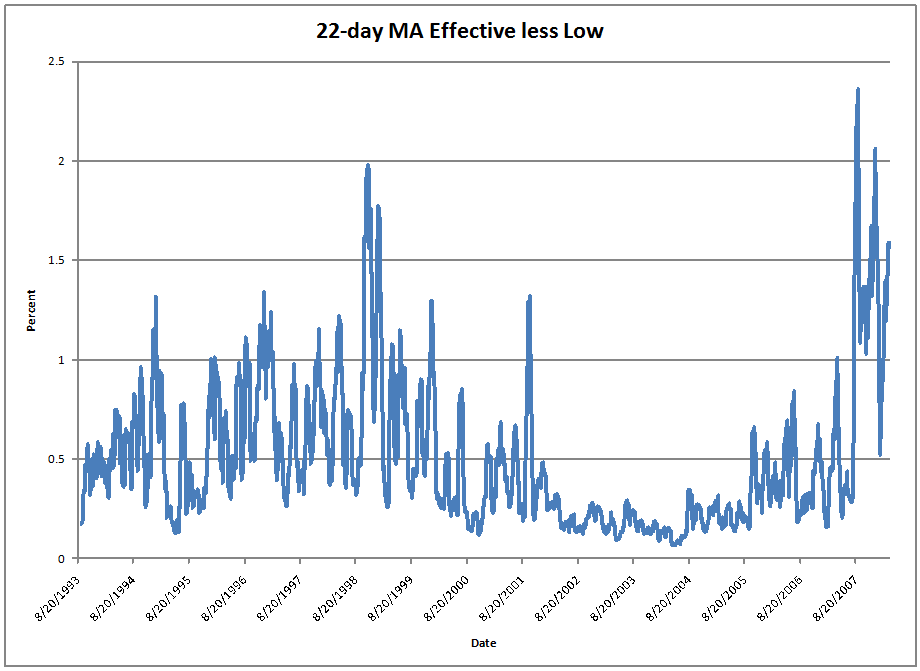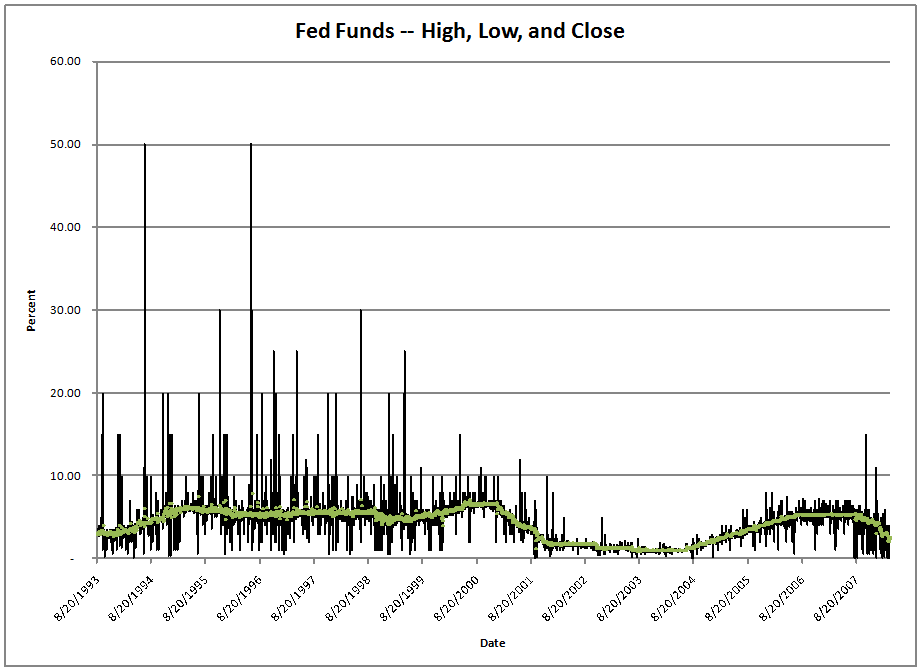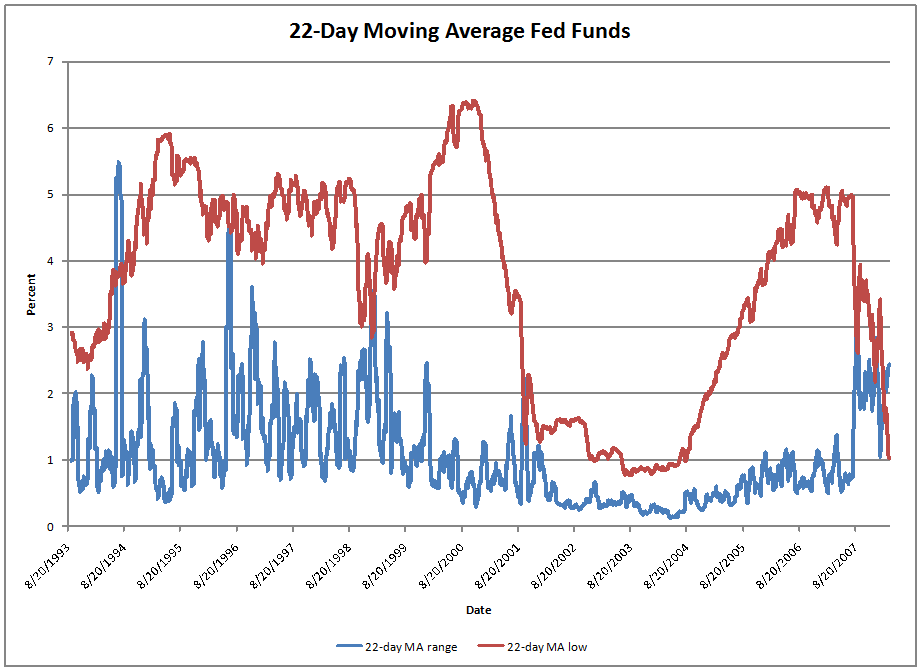Fourteen Notes on Monetary Policy
This post is on current monetary policy. The review piece on how monetary policy works is yet to come.
1) Let’s start out with the regulatory issues to get them out of the way, beginning with Bear Stearns. To me, the most significant thing to come out of the “rescue” was the Federalizing of losses from the loans that were guaranteed by the Fed (something which I noted before had to be true, since the Fed turns over its profits to the Treasury), and the waiving of many leverage rules for the combined entity (also here and here). These in turn led to an attitude that if the Fed was going to lend to Bear (however indirectly), then they should be regulated by the Fed.
Now, I don’t blame the Fed for bailing out Bear, because they were “too interlinked to fail.” You could say, “Too big to fail,” but only if you measure big by the size of the derivatives book. The last thing that the investment banks needed was a worry on concentrated counterparty risk affecting the value of their derivative books.
That said, given that Jamie Dimon was very reluctant to help unless the Fed provided guarantees, and the low price paid, it indicates to me that Bear and the Fed were desperate to get a deal done. What was in it for Bear? I’m not sure, but the deal avoided greater ignominy for the board, and might preserve jobs at Bear for a longer period of time.
2) At a time like this, many cry for tighter regulation in the the intermediate-term and more aggressive actions in the short-term to restore liquidity. Forget that the two of these fight each other. Personally, I find the comments from the IMF amusing because they are an institution in search of a mission; the IMF was designed to help developing nations, not developed ones. The comments from the FDIC Chairwoman are good, but really, where were the banking regulators in 2005-2006, when something useful could have been done?
3) Does the Fed want to be a broader financial regulator? My initial guess would be “no,” but I could be wrong here. Part of my reasoning is that they have not used the powers effectively that they already have. Another part is that monetary policy has often been misused, and been pro-cyclical. With their new powers, they will still face significant noise and data lags. Why should they be more successful at a more complex task than they have been with the less complex task of monetary policy? Schiller is way too optimistic here. The central bankers are part of the problem here, not part of the solution. For years they provided too much liquidity in an effort to keep severe recessions from occurring, and in the process they removed fear from the financial system, and too much leverage and bad underwriting built up. Now the piper has to be paid.
4) Eric Rosengren, president of the Federal Reserve Bank of Boston, comments on the difficulties involved in effective regulation of financial institutions as a lender of last resort.? The Fed will have to build new models, and think in new paradigms.
5)? Charles Plosser, President of the Philadelphia Fed, tells us not to overestimate monetary policy.? Sage words, and rarely heard from the Fed (though in my experience, more often heard toward the end of a loosening cycle).? Plosser moves up a couple of notches in my view… monetary policy can deal with price inflation, and that’s about it.? Once we try to do more than that, the odds of making a mistake are significant.
6)? Who loses when the Fed loosens?? Savers.? They earn less; there is a net transfer of wealth from savers to borrowers.? Holders of US-dollar based fixed income assets also bear the brunt, if thy have to convert it back to their harder currency.
7)? Perhaps the TSLF is succeeding.
8 ) But perhaps all of the Fed’s efforts on the asset side are making it more difficult for Fed to keep the fed funds market stable.? I have one more graph that stems from my recent piece on the Fed:

Note that during the past six months, the low transaction on Fed funds was significantly below the effective rate.
9) VIX and More has latched onto this calculation of M3.? Given the changes and the adjustments that they have made, and the 20% or so rate of growth for M3, I would want to see a “spill” of the calculation to see what’s going on.? Perhaps there has been some double-counting.
Now, if we are talking about MZM (all monetary liabilities immediately redeemable at par) , we are facing high rates of growth — around 17% YOY.

My M3 proxy, total bank liabilities, is running ahead at a 13%+ rate.? Only the monetary base stays in the mud with barely 2% growth.? I still think that the Fed is trying to restrain inflation through no monetary base growth, while allowing the healthy banks to grow aggressively.? So much for supervision.
10)? Reading the H.4.1 report the past weeks have had the Fed lending more directly through their new programs, and selling Treasuries to keep the Fed’s balance sheet from growing.
11) I expect the minutes tomorrow to reveal little that is new; if anything, it will highlight the competing pressures that the Fed is trying to deal with.
12) For a view compatible with mine, read Bob Rodriguez of First Pacific Advisors.? One of my favorite equity managers, and he is doing well in the present environment.
13) The yield curve and Fed funds futures indicate another 25-50 basis points of easing in this cycle, at least, until the next institution blows up.
14) Finally, and just for fun — two guys I would nominate for the Federal Reserve Board — Ron Paul and James Grant.? Toss in Steven Hanke, and it starts to get interesting.


 )
)


